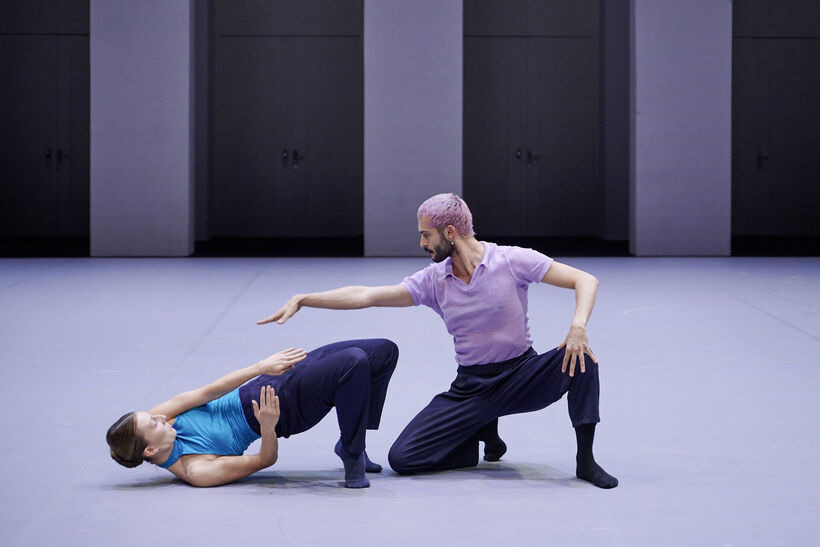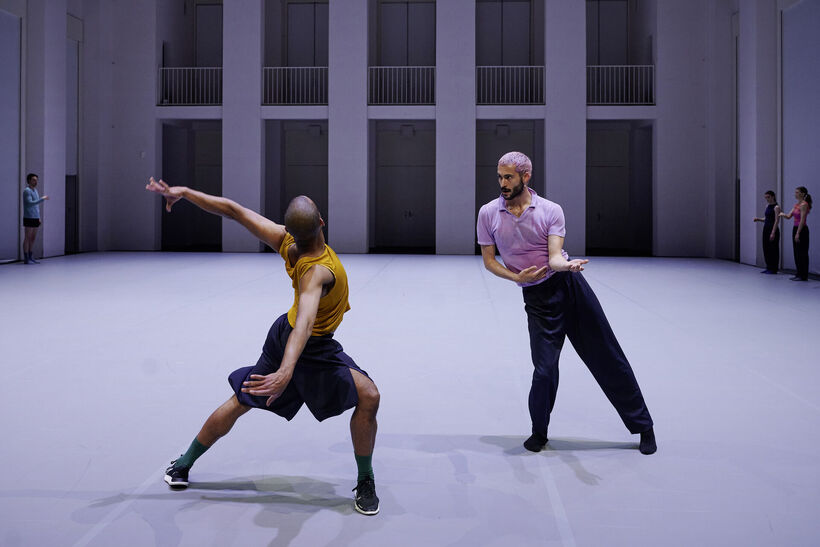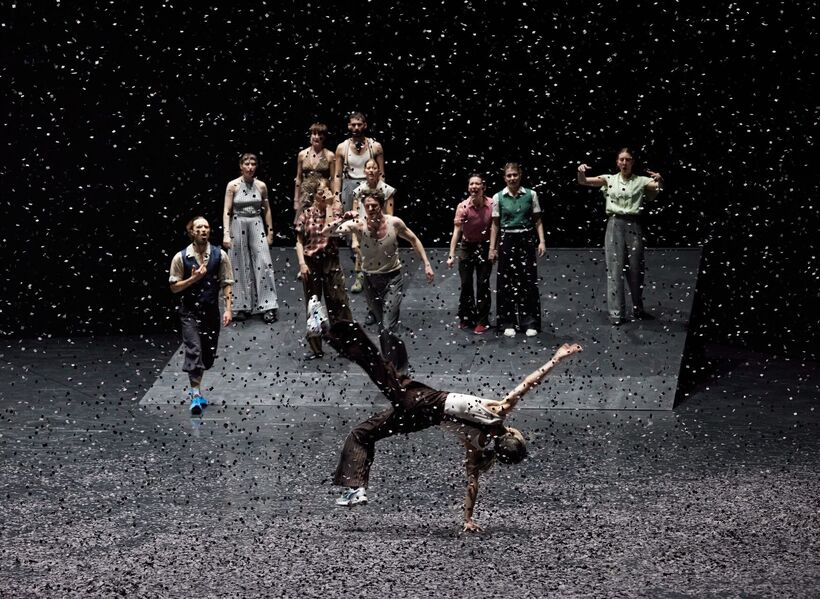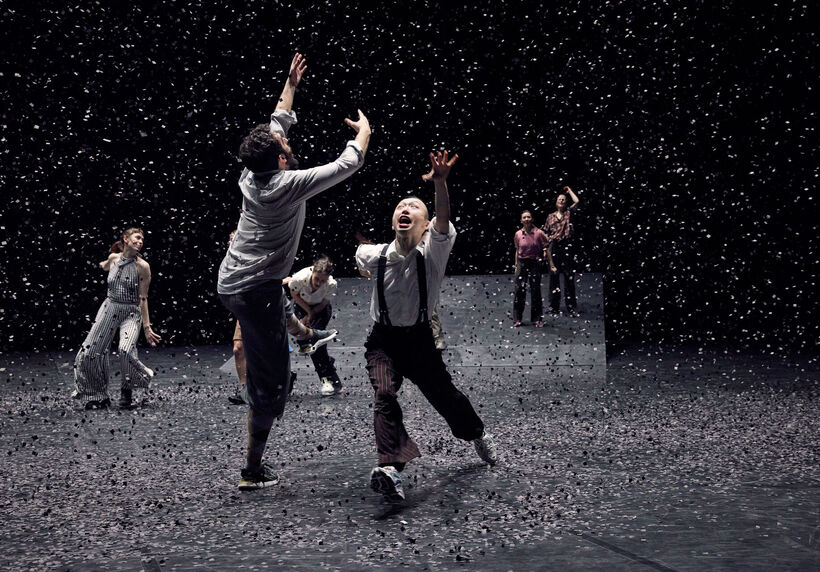Dresden Frankfurt Dance Company: Improvisational Quests at the Romaeuropa Festival
In an evening highlighting the transmission of legacy within the Dresden Frankfurt Dance Company, this year’s Romaeuropa festival – Rome’s largest international performing arts festival – presented Undertainment by William Forsythe and Lisa by Ioannis Mandafounis. Rooted in improvisational techniques – Forysthe’s improvisation toolbox and Mandafounis’ live-choreography –, a double bill performance unfolded through unexpected paths, offering a vibrant experience that never repeats itself in exactly the same way.

Undertainment by William Forsythe. Photo: Stephan Floss.
REF: Rome’s autumn performing arts festival
With 40 editions to date, the advent of the Romaeuropa festival (REF, 4 September to 16 November 2025) marks the gradual transition from summer to winter in the Italian capital each year. Revolving around the axes of memory and future, utopia and reality, this year’s edition offers a wide range of artistic experiences, such as Afanador, an eccentric and flamenco-based work by Marcos Morau, which was made for the Ballet Nacional de España and kicked off the festival. Composed of a main programme that includes dance, theatre, and music, REF is also interlaced with ULTRA REF – a section that transcends disciplinary boundaries and features, among others, a short focus on Lithuanian artists, the “Dancing Days” section, built in dialogue with the Aerowaves European dance network, and Anni Luce, a showcase dedicated to promising Italian theatre companies. Over the last three weekends, the festival targets younger audiences with a variety of performances conceived for children. Within a frame of artistic excellence, REF seeks to combine international perspectives with the voices of artists based in Italy, presenting a programme that balances works by established, mid-career, and emerging artists, reaching out to an intergenerational audience.

The Dresden Frankfurt Dance Company (DFDC) double bill, featuring pieces by William Forsythe and Ioannis Mandafounis and co-commissioned by REF, was supported by Dance Reflections by Van Cleef & Arpels, a key REF partner since 2022. This partnership also makes the presentation of several other dance pieces in this year’s REF possible, including Soirée d’Etudes by Cassiel Gaube (25-26 September), Chronicles by (La)HORDE Ballet National de Marseille (1–3 October), Terrapolis by Qudus Onikeku (14 October), and Christos Papadopoulos’ My Fierce Ignorant Step, scheduled for 14–16 November.
Both choreographers, Forsythe and Mandafounis, need little introduction. Forsythe has received international recognition for his groundbreaking work innovating ballet since the last quarter of the twentieth century. As a director of the Ballet Frankfurt (1984–2004) and founder of The Forsythe Company (2004–2015) – later renamed the Dresden Frankfurt Dance Company – he opened ballet to dance improvisation, rethinking, as well as deconstructing, its core principles through the lenses of mathematics and geometry. Continuing in the footsteps of Forsythe, acclaimed Greek choreographer Mandafounis is a former dancer of The Forsythe Company and current Director of the Dresden Frankfurt Dance Company since 2023, continuing to expand his master’s improvisation tools towards a format that he calls “live-choreography”. Improvisation is the common thread in the creative and actualisation process of both pieces.
Form following improvisation
Forsythe’s Undertainment is a choral piece in which the entire DFDC ensemble is present on stage throughout the whole piece to envelop the pop-up solos or duets that emerge unexpectedly. The dancers produce the live soundscape that accompanies the structured improvisation. Syllables and vowels – “ba-ba-ba”, “o”, “u” among others – emerge in a popcorn-like vocal composition and are enriched by whistles and more tactile sounds such as the patting down of their trousers. Subtle cues exchanged within the group serve as points of communication between the dancers, for instance to allow them to synchronise themselves when shifting from a line to a circle. At times, the ensemble moves in perfect unison and in these sporadic moments, the multiplication of the single gesture or sound generates a striking aural and visual volume on stage.

Undertainment is representative of Forsythe’s movement signature: the fluidity and freedom of contemporary dance combined with the precision and control of ballet technique. This explosive amalgam of movement expression is approached with an athletic attitude, characterised by body twists, space tracing, the use of the negative space between and around the dancer’s bodies, and sudden stops that interrupt the flow of movement. Dressed in comfortable clothes and trainers, the dancers are engaged in an improvisation process so impressively and precisely orchestrated that it often comes across as a fixed choreography. More than once, I caught myself wondering whether Undertainment was really improvised or if it was in fact a meticulously composed piece. The intense presence and acute alertness of the dancers allow the improvisation to unfold, channelled towards a heightened sense of group relationality. This is a choreographic approach and a performance state that can only be achieved through the impulses of structured improvisation. Considering that Undertainment is supposedly the last piece made for the stage by Forsythe, I felt nostalgic about this particular performance mode, so unique to Forsythe’s style and legacy.
Improvisation opening to (anti)-narratives
Although Mandafounis’ creative approach in Lisa also stems from improvisation, its tone and atmosphere differ radically from Undertainment. Lisa transports us to the 1930s, a period with striking similarities to today in terms of the rise of totalitarian power. Dressed in earth-toned outfits freely inspired by 1930s urban fashion, the dancers are given agency and the responsibility to choose when to enter or exit the stage. Throughout the performance, they recite excerpts from the poems of Osip Mandelstam (1891–1938), the Russian anti-Stalin and anti-conformist poet. As this process unfolds, the dancers energetically run, turn, and spiral in space under the melodic sounds of several of Gabriel Fauré’s (1845–1924) Nocturnes, performed live by the pianist Gabriele Carcano. The live-choreography bursts into forceful high jumps, sudden lifts, and horizontal slides, emerging between hand-held body chains. Bodies wrap and unwrap, constantly on the verge of falling or reaching skyward. Lisa’s climax builds slowly, gradually becoming explosive and shifting into a Babel-like crescendo – chaotic in movement and layered in linguistic complexity, as the dancers recite Mandelstam's poetry in multiple languages. Amid this blurriness and confusion and under a rain of confetti, a hug pierces through the chaos to give hope to the power of human connection.

While in Undertainment, the improvisation is mostly dependent on the dancers, in Lisa the unpredictability also seems to extend to the technical crew and perhaps even the musician, especially when confetti suddenly falls from above to cover the stage, when the pianist unexpectedly abandons the performance, or even when Lisa comes to an abrupt end when the lights are turned off. The whole evening evolves out of a composition based on abstract movement, developing into a context where words, music, and costumes seek to create narrative threads that remain intentionally unfulfilled. While improvisation is intriguing to follow when the movement is abstract and relies on the fundamental ingredients of space and time manipulation, once additional layers of spoken text, music, and non-neutral clothes are introduced, the experience becomes deliberately disorienting, challenging the audience to seek meaning or surrender to the absurd.
Both pieces meet in the present through improvisation. Curiously, Undertainment gazes into the future through a corporeal legacy passed from Forsythe to Mandafounis, while Lisa looks back into the past and to a particular point in time during the twentieth century, which has striking parallels to our contemporaneity. Both are so meticulously orchestrated that it is hard to imagine how their future iterations might differ. For this reason, as audience members, we must recognise that each performance is a one-time experience – never to be repeated in the same way. This is a unique characteristic that invites us to embrace the unknown, accepting that it may sometimes disappoint us, while also holding the power to surprise and enchant us.

Written from the performance of 9 September 2025 at Auditorium Concillazione, Rome, Italy.
Undertainment
Choreography: William Forsythe
Dance: The dancers of the Dresden Frankfurt Dance Company
Choreographic Assistance: Cyril Baldy
Rehearsal Manager: Pauline Huguet
Lighting: Tanja Rühl
Costumes: Dorothee Merg
World premiere production Undertainment 2025: In Coproduction with DE SINGEL – International Arts Centre and the Romaeuropa Festival.
World Premiere Dresden: 23 May 2025
Frankfurt Premiere: 5 June 2025.
Lisa
Choreography: Ioannis Mandafounis
Dance: Dancers Of The Dresden Frankfurt Dance Company
Costumes: Dorothee Merg
Piano: Gabriele Carcano
Dramaturgy: Philipp Scholtysik
Choreographic Assistance: Pauline Huguet
Stage and Lighting: Ioannis Mandafounis
World Premiere Frankfurt: 28 March 2024.







